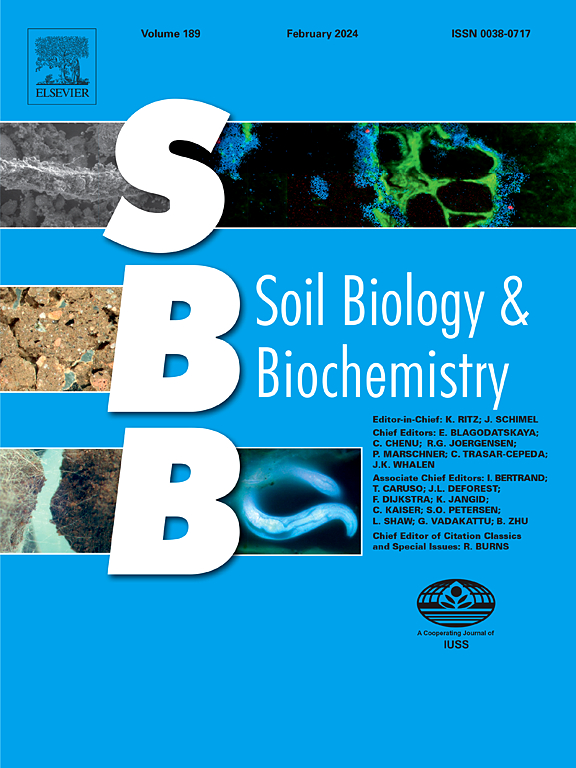Genetic lineages and ecological gradients co-determine the trophic niches of earthworms
IF 9.8
1区 农林科学
Q1 SOIL SCIENCE
引用次数: 0
Abstract
Trophic niche partitioning is a fundamental mechanism explaining species coexistence and diversity. Trophic niches vary with elevational gradients, but the consequences of genetic divergence for trophic niche shifts are little studied in particular for belowground communities. Many earthworm species comprise various genetic lineages, however, the trophic niche variations of these co-existing lineages under gradually changing environmental conditions is still unknown. This study barcoded 280 individuals of earthworm Eisenia nordenskioldi sampled from an elevational gradient (800–1700 m) on Changbai Mountain in northeastern China and divided them into two lineages (i.e., large and small bodied). Using normalized stable isotope ratios (Δ), we evaluated the trophic niche shifts of the two distinct lineages across seven elevations. The results showed that genetic lineage and elevation together explained the variations of isotopic compositions (72.9% for Δ13C and 95.4% for Δ15N). Ignoring the elevations, the two lineages showed no significant difference in their trophic niches (P > 0.05) with a 27% of overlap; while when they co-occurred at certain elevations, the two lineages overlapped by 7–24% in trophic niches, and showed significant differences. The trophic niche sizes of two lineages changed significantly but in an opposite way with elevations. The significant differences in trophic niches indicated that the two lineages had different physiologies, supporting their status as cryptic species. For both lineages, the Δ13C values showed a hump-shaped relationship with body mass, while the Δ15N values decreased linearly with body mass; litter C/N ratio and soil moisture explained variations of Δ13C values, and litter C/N ratio and soil pH explained the variations of Δ15N values. Overall, the findings highlight the power of integrating the genetic and ecological information and the novel fact that intraspecific variations in trophic traits can be of similar importance to those among different species when evaluating the responses to environmental changes.

遗传谱系和生态梯度共同决定蚯蚓的营养生态位
营养生态位划分是解释物种共存和多样性的基本机制。营养生态位随海拔梯度的变化而变化,但遗传分化对营养生态位变化的影响研究很少,特别是对地下群落。许多蚯蚓物种包括各种遗传谱系,然而,这些共存谱系在逐渐变化的环境条件下的营养生态位变化仍然是未知的。本文对长白山海拔800 ~ 1700 m处的280只北氏爱森蚓(Eisenia nordenskioldi)进行了条形码鉴定,并将其划分为大体和小体两个谱系。利用归一化稳定同位素比值(Δ),我们评估了两个不同谱系在7个海拔高度上的营养生态位变化。结果表明,遗传谱系和海拔高度共同解释了同位素组成的变化(Δ13C为72.9%,Δ15N为95.4%)。忽略海拔高度,两个世系的营养生态位没有显著差异(P >;0.05),重叠度为27%;而当它们在一定海拔高度同时发生时,两个世系在营养生态位上重叠7-24%,并表现出显著差异。两个世系的营养生态位大小随海拔的升高而显著变化,但变化方向相反。营养生态位的显著差异表明这两个世系具有不同的生理特征,支持了它们作为隐种的地位。对于两个世系,Δ13C值与体重呈驼峰型关系,而Δ15N值随体重呈线性下降;凋落物C/N和土壤水分解释了Δ13C值的变化,凋落物C/N和土壤pH解释了Δ15N值的变化。总的来说,这些发现强调了整合遗传和生态信息的力量,以及在评估对环境变化的反应时,营养性状的种内变化与不同物种之间的变化具有相似的重要性。
本文章由计算机程序翻译,如有差异,请以英文原文为准。
求助全文
约1分钟内获得全文
求助全文
来源期刊

Soil Biology & Biochemistry
农林科学-土壤科学
CiteScore
16.90
自引率
9.30%
发文量
312
审稿时长
49 days
期刊介绍:
Soil Biology & Biochemistry publishes original research articles of international significance focusing on biological processes in soil and their applications to soil and environmental quality. Major topics include the ecology and biochemical processes of soil organisms, their effects on the environment, and interactions with plants. The journal also welcomes state-of-the-art reviews and discussions on contemporary research in soil biology and biochemistry.
 求助内容:
求助内容: 应助结果提醒方式:
应助结果提醒方式:


